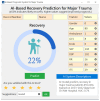"Could She/He Walk Out of the Hospital?": Implementing AI Models for Recovery Prediction and Doctor-Patient Communication in Major Trauma
- PMID: 40647581
- PMCID: PMC12249231
- DOI: 10.3390/diagnostics15131582
"Could She/He Walk Out of the Hospital?": Implementing AI Models for Recovery Prediction and Doctor-Patient Communication in Major Trauma
Abstract
Background and Objectives: Major trauma ranks among the leading causes of mortality and handicap in both developing and developed countries, consuming substantial healthcare resources. Its unpredictable nature and diverse clinical presentations often lead to rapid and challenging-to-predict changes in patient conditions. An increasing number of models have been developed to address this challenge. Given our access to extensive and relatively comprehensive data, we seek assistance in making a meaningful contribution to this topic. This study aims to leverage artificial intelligence (AI)/machine learning (ML) to forecast potential adverse effects in major trauma patients. Methods: This retrospective analysis considered major trauma patient admitted to Chi Mei Medical Center from 1 January 2010 to 31 December 2019. Results: A total of 5521 major trauma patients were analyzed. Among five AI models tested, XGBoost showed the best performance (AUC 0.748), outperforming traditional clinical scores such as ISS and GCS. The model was deployed as a web-based application integrated into the hospital information system. Preliminary clinical use demonstrated improved efficiency, interpretability through SHAP analysis, and positive user feedback from healthcare professionals. Conclusions: This study presents a predictive model for estimating recovery probabilities in severe burn patients, effectively integrated into the hospital information system (HIS) without complex computations. Clinical use has shown improved efficiency and quality. Future efforts will expand predictions to include complications and treatment outcomes, aiming for broader applications as technology advances.
Keywords: artificial intelligence; hospital information systems; machine learning; major trauma patient; mortality; prognosis; recovery.
Conflict of interest statement
The authors declare no conflicts of interest.
Figures
Similar articles
-
Are Current Survival Prediction Tools Useful When Treating Subsequent Skeletal-related Events From Bone Metastases?Clin Orthop Relat Res. 2024 Sep 1;482(9):1710-1721. doi: 10.1097/CORR.0000000000003030. Epub 2024 Mar 22. Clin Orthop Relat Res. 2024. PMID: 38517402
-
Development of a machine learning model and a web application for predicting neurological outcome at hospital discharge in spinal cord injury patients.Spine J. 2025 Jul;25(7):1483-1493. doi: 10.1016/j.spinee.2025.01.005. Epub 2025 Jan 31. Spine J. 2025. PMID: 39894282
-
[Volume and health outcomes: evidence from systematic reviews and from evaluation of Italian hospital data].Epidemiol Prev. 2013 Mar-Jun;37(2-3 Suppl 2):1-100. Epidemiol Prev. 2013. PMID: 23851286 Italian.
-
Comparison of Two Modern Survival Prediction Tools, SORG-MLA and METSSS, in Patients With Symptomatic Long-bone Metastases Who Underwent Local Treatment With Surgery Followed by Radiotherapy and With Radiotherapy Alone.Clin Orthop Relat Res. 2024 Dec 1;482(12):2193-2208. doi: 10.1097/CORR.0000000000003185. Epub 2024 Jul 23. Clin Orthop Relat Res. 2024. PMID: 39051924
-
The Lived Experience of Autistic Adults in Employment: A Systematic Search and Synthesis.Autism Adulthood. 2024 Dec 2;6(4):495-509. doi: 10.1089/aut.2022.0114. eCollection 2024 Dec. Autism Adulthood. 2024. PMID: 40018061 Review.
References
-
- Montoya L., Kool B., Dicker B., Davie G. Epidemiology of major trauma in New Zealand: A systematic review. N. Z. Med. J. 2022;135:86–110. - PubMed
LinkOut - more resources
Full Text Sources




